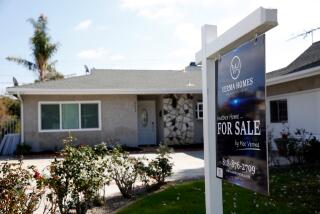‘88 Outlook Bright for U. S. Real Estate
- Share via
Even with the inherent problems of dealing with housing affordability, land use, moratoriums, water shortage and sewer replacement, prospects for the Southern California real estate industry in particular, and the rest of the nation, appear bright for 1988.
Usually optimistic home builders believe that in this national election year interest rates will not get out of hand and will remain stable--under 11% for fixed-rate mortgages.
Their counterparts in the resale housing field expect a slower pace, maybe a drop of 10%, after 1987, which turned out to be the best resale year statewide since 1979.
And in the commercial realty field, investor needs in the Los Angeles market area are expected to outpace supply. That will happen principally because the Los Angeles basin has the economic and geographic characteristics desired by local and foreign investors.
That point will be highlighted in the fifth annual commercial realty forecast by Grubb & Ellis Commercial Brokerage Services at a briefing session Thursday at the Los Angeles Hilton.
Referring to the Oct. 19 stock market plunge, Michael Randall, investment properties specialist and senior marketing consultant with the firm, said that except for “a few canceled escrows from panicked buyers,” it had a very minor effect on real estate.
While real estate yields have been lagging behind the stock market for five years, he said, the stock market drop proved again the volatility of stocks.
“The general public and astute investors got a very real reminder that one strength of real estate is long-term stability. Prudent investing is difficult in a stock market which is subject to overnight swings,” he said.
In his assessment, “psychologically, real estate got a favorable nod from the crash.”
Despite vacancy rates in the 20% range, Randall and others believe strongly that the principal foreign investments will continue to be made by aggressive Japanese firms, seeking so-called “trophy buildings.”
Since the number of dominant office structures is limited, however, alternate kinds of buildings and suburban locations will soon attract foreign buyers in greater numbers, Randall predicted.
The Grubb & Ellis report estimates that Japanese capital will buy $10 billion worth of United States real estate this year, up more than 10% from 1987, and over 50% from 1986. Meanwhile, all the other major foreign buyers combined--from Korea, Canada, the Netherlands, United Kingdom and West Germany--will probably buy less than half of the Japanese total, Randall guessed.
While foreign buyers get much public attention, the nation’s economy is again expected to be headed by activity in the home construction industry.
Housing starts will probably reach the 1.55-million mark, shy of the estimated 1.6 million units built last year, according to Stan Ross, co-managing partner of Kenneth Leventhal & Co., certified public accountants.
He expects stability in interest rates, at least through the third quarter.
American households, he said, are continuing to become smaller, and as much as 25% of the population may be living alone by 1989. By other estimates, the typical family will then have 2.5 persons. In 1986, the figure was 2.7.
Such increasingly smaller households would result in the need for construction of smaller-sized houses as well as more rental housing, for both moderate-income and affluent retirees, and for the elderly. Multifamily and condominium housing also could play larger roles.
We would like to inform this section’s readers, belatedly, of the recent death of Leavitt Dudley, an illustrator whose precise and clear-cut renderings graced scores of our front pages for more than a quarter-century.
The greatest compliment for him would be the often-made remark by builders and developers:
“I hope my project looks as good as Dudley’s drawings.”
More to Read
Inside the business of entertainment
The Wide Shot brings you news, analysis and insights on everything from streaming wars to production — and what it all means for the future.
You may occasionally receive promotional content from the Los Angeles Times.










